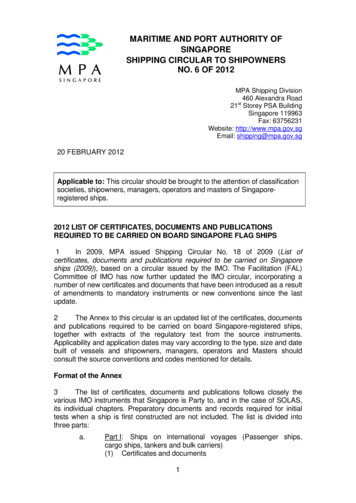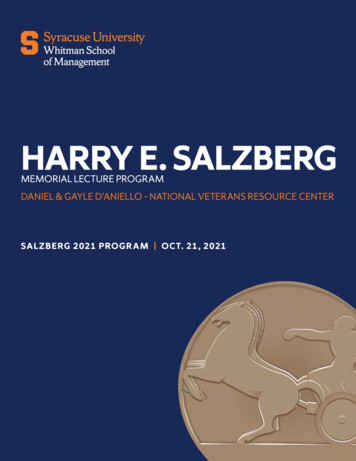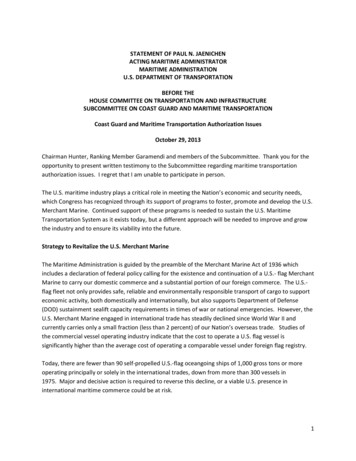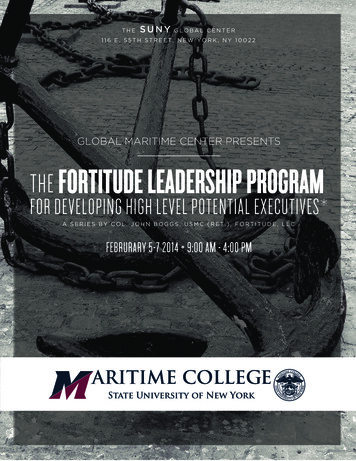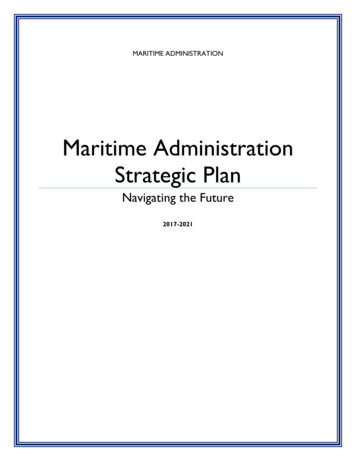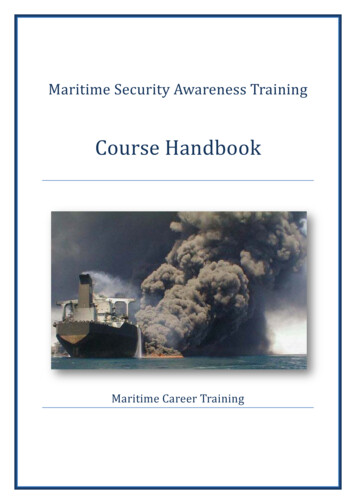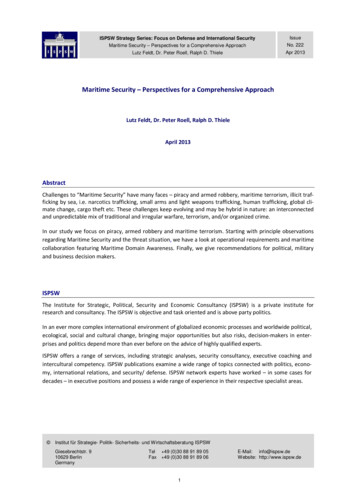
Transcription
ISPSW Strategy Series: Focus on Defense and International SecurityIssueMaritime Security – Perspectives for a Comprehensive ApproachNo. 222Lutz Feldt, Dr. Peter Roell, Ralph D. ThieleApr 2013Maritime Security – Perspectives for a Comprehensive ApproachLutz Feldt, Dr. Peter Roell, Ralph D. ThieleApril 2013AbstractChallenges to “Maritime Security” have many faces – piracy and armed robbery, maritime terrorism, illicit trafficking by sea, i.e. narcotics trafficking, small arms and light weapons trafficking, human trafficking, global climate change, cargo theft etc. These challenges keep evolving and may be hybrid in nature: an interconnectedand unpredictable mix of traditional and irregular warfare, terrorism, and/or organized crime.In our study we focus on piracy, armed robbery and maritime terrorism. Starting with principle observationsregarding Maritime Security and the threat situation, we have a look at operational requirements and maritimecollaboration featuring Maritime Domain Awareness. Finally, we give recommendations for political, militaryand business decision makers.ISPSWThe Institute for Strategic, Political, Security and Economic Consultancy (ISPSW) is a private institute forresearch and consultancy. The ISPSW is objective and task oriented and is above party politics.In an ever more complex international environment of globalized economic processes and worldwide political,ecological, social and cultural change, bringing major opportunities but also risks, decision-makers in enterprises and politics depend more than ever before on the advice of highly qualified experts.ISPSW offers a range of services, including strategic analyses, security consultancy, executive coaching andintercultural competency. ISPSW publications examine a wide range of topics connected with politics, economy, international relations, and security/ defense. ISPSW network experts have worked – in some cases fordecades – in executive positions and possess a wide range of experience in their respective specialist areas. Institut für Strategie- Politik- Sicherheits- und Wirtschaftsberatung ISPSWGiesebrechtstr. 910629 BerlinGermanyTelFax 49 (0)30 88 91 89 05 49 (0)30 88 91 89 061E-Mail: info@ispsw.deWebsite: http://www.ispsw.de
ISPSW Strategy Series: Focus on Defense and International SecurityIssueMaritime Security – Perspectives for a Comprehensive ApproachNo. 222Lutz Feldt, Dr. Peter Roell, Ralph D. ThieleApr 2013ANALYSIS1.Maritime SecurityTo many observers “Maritime Security” appears to be a large and sometimes nebulous concept. In fact it hasbecome a large task involving many entities from international, public and private sectors aiming at preserving the freedom of the seas, facilitating and defending commerce, and maintaining good governance at sea.Transnational forces and irregular challenges continue to be the primary threat today and in the foreseeablefuture, especially in the maritime domain. “Maritime Security” has to be distinguished from “Maritime Safety”.“Maritime Security” is “the combination of preventive and responsive measures to protect the maritime1domain against threats and intentional unlawful acts ”. Key words are: preventive and responsive measures,aiming at both law enforcement as a civilian and military requirement and defense operations as a military, inthis case naval requirement. “Maritime Safety” is “the combination of preventive and responsive measuresintended to protect the maritime domain against, and limit the effect of, accidental or natural danger, harm,2and damage to environment, risks or loss.”The crucial distinction is between man-made and unintentional risks and dangers. “Safety” refers to dangers forships, its crew and passengers, cargo and navigation. It is referring to the protection of the maritime environment through regulations and techniques, whereas security is focused on operational requirements. Safety is acivilian responsibility. And its achievements are based on common efforts between governmental and non3governmental actors. The “International Maritime Organization” , IMO, is the guardian of all regulations neces4sary to establish and keep appropriate standards. One example is the “Best Management Practice” , BMP 4,published to advise all ship owners and masters to be able to protect themselves against piracy attacks andarmed robbery.“Maritime Security” is a responsibility, which has no clear definitions when it comes to Maritime SecurityOperations: it is a governmental responsibility, but the authority to act on behalf of a state is a sovereign decision with different options. This has a strong influence on Maritime Collaboration. It has no universal legal oragreed definition due to the fact that it is a broad topic, covering many policy sectors. Elements, which are partof maritime security, are: International and national peace and security Sovereignty, territorial integrity and political s/wcm/connect/44d0718042982ce1bb66bb24ab1546e8/The wise pen team final reportapril 2010.pdf?MOD AJPERES&CACHEID bb66bb24ab1546e8/The wise pen team final reportapril 2010.pdf?MOD AJPERES&CACHEID ia.org/wiki/International Maritime ics/piracy/documents/1339.pdf Institut für Strategie- Politik- Sicherheits- und Wirtschaftsberatung ISPSWGiesebrechtstr. 910629 BerlinGermanyTelFax 49 (0)30 88 91 89 05 49 (0)30 88 91 89 062E-Mail: info@ispsw.deWebsite: http://www.ispsw.de
ISPSW Strategy Series: Focus on Defense and International SecurityIssueMaritime Security – Perspectives for a Comprehensive ApproachNo. 222Lutz Feldt, Dr. Peter Roell, Ralph D. ThieleApr 2013 Security of Sea Lines of Communications Security protection from crimes at sea Resource security, access to resources at sea and to the seabed Environmental protection Security of all seafarers and fishermen.Referring to the responsibility for maritime security, all nations have a responsibility by signing UNCLOS5 or bybeing compliant with this broad set of articles and regulations which are offering a foundation for “GoodGovernance at Sea”. All maritime regimes, be they based on UNCLOS or derive from this basic document, bethey regional or local, must ensure or, in critical situations, enforce compliance with this globally accepteddocument.Having described the term “Maritime Security” and concluded that there is no universal definition, it is of equalimportance to think about the term “Comprehensive Approach”. The character of the seas has changed. Froman open space where freedom was the rule, they have now turned into a shared, common domain, vast butfragile, needing world- wide management and protection.Knowing that a sectoral approach has only limited success, the term “Comprehensive Approach” seems, atleast, to mean that more than one authority is engaged to contribute to “Maritime Security”. Collaborationbetween different national and international authorities is of equal importance. Having decided, for the timebeing, to focus on operational requirements, ignoring technical ones, we concentrate on so-called “enablers”.These are maritime skills developed through a combination of long experience, common exercise, commonoperations and a common set of rules, which are provided by the military and civil community. “Rules of6Engagement” are available for both: maritime security and defense.2.Piracy and Armed Robbery2.1DefinitionsIn article 101 of the 1982 United Nations Convention on the Law of the Sea (UNCLOS) “Piracy” is defined asfollows: 56any illegal acts of violence or detention, or any act of depredation, committed for private ends by thecrew or the passengers of a private ship or a private aircraft, and directed:oon the high seas, against another ship or aircraft, or against persons or property on board suchship or aircraft;oagainst a ship, aircraft, persons or property in a place outside the jurisdiction of any State;http://www.un.org/Depts/los/convention agreements/texts/unclos/unclos b07-48f2-af0a-7474e92d0bb0/San-Remo-ROE-Handbook Institut für Strategie- Politik- Sicherheits- und Wirtschaftsberatung ISPSWGiesebrechtstr. 910629 BerlinGermanyTelFax 49 (0)30 88 91 89 05 49 (0)30 88 91 89 063E-Mail: info@ispsw.deWebsite: http://www.ispsw.de
ISPSW Strategy Series: Focus on Defense and International SecurityIssueMaritime Security – Perspectives for a Comprehensive ApproachNo. 222Lutz Feldt, Dr. Peter Roell, Ralph D. ThieleApr 2013 any act of voluntary participation in the operation of a ship or of an aircraft with knowledge of factsmaking it a pirate ship or aircraft; any act of inciting or of intentionally facilitating an act described before.7The International Maritime Organization (IMO) in its 26th Assembly session defines Armed Robbery inResolution A.1025 “Code of Practice for the Investigation of Crimes of Piracy and Armed Robberyagainst Ships” as follows:“Armed robbery against ships,” means any of the following acts: any illegal act of violence or detention or any act of depredation, or threat thereof, other than an actof piracy, committed for private ends and directed against a ship or against a person or property onboard such a ship, within a State’s internal waters, archipelagic waters and territorial sea; any act of inciting or of intentionally facilitating an act described above.2.28Threat SituationLooking at the threat situation generated by piracy off the coast of Somalia and in the Indian Ocean, we canobserve two different developments. In the last couple of years the good cooperation between Singapore,Malaysia and Indonesia has successfully combated piracy in this region. Piracy, once rampant, has been largelyexterminated because the littoral states in the region have stepped up their anti-piracy efforts. These effortsinclude the operation “Eye in the Sky” and Malacca Strait Patrols, involving coordinated and sometimes jointIndonesian, Malaysian, Singaporean as well as Thai air and sea surveillance operations, including a considerableinformation exchange. They have also invited cooperation from outside powers such as India, the United States9and Japan.The situation off the coast of Somalia is just opposite to that. Although the International Chamber ofCommerce (ICC) and the International Maritime Bureau (IMB) reported on October 22, 2012 that, despite thefact that the number of ships signaling attacks by Somali pirates has fallen this year to its lowest level since102009, the greatest threat for international shipping still comes from activities by Somali pirates.Updated on December 3, 2012 the IMB reported for Somalia the following figures: Total incidents: 71 Total hijackings: 13 Total hostages: 2127United Nations Convention on the Law of the Sea, 10 December 1982, 60-1.http://www.un.org/Depts/los/convention agreements/convention overview convention.htm.8International Maritime Organization (IMO), Assembly 26th session, Resolution A.1025, 18 January 2010, 4.9Mark J. Valencia and Nazery Khalid, “The Somalia Multilateral Anti-Piracy Approach: Caveats on Vigilantism”, The Asia-PacificJournal: Japan Focus, http://www.japanfocus.org/-Mark J -Valencia/3052# (accessed 9 September 2012).10ICC International Chamber of Commerce, „IMB reports drop in Somali piracy, but warns against omplacency (accessed 8 December2012). Institut für Strategie- Politik- Sicherheits- und Wirtschaftsberatung ISPSWGiesebrechtstr. 910629 BerlinGermanyTelFax 49 (0)30 88 91 89 05 49 (0)30 88 91 89 064E-Mail: info@ispsw.deWebsite: http://www.ispsw.de
ISPSW Strategy Series: Focus on Defense and International SecurityIssueMaritime Security – Perspectives for a Comprehensive ApproachNo. 222Lutz Feldt, Dr. Peter Roell, Ralph D. ThieleApr 2013Current vessels held by Somali pirates: Vessels: 9 Hostages: 14711However, not a single case has been reported yet where a ship carrying armed contractors was hijacked. This,combined with the naval activities of the multinational task force, has made life very difficult for the Somalipirates. Also, pirate activities decreased considerably along the Indian coast because last year, the Indian navyincreased their patrols, enhanced surveillance and joined NATO forces in joint patrols. However, analysts alsobelieve that the increased use of private security guards on ships, international naval patrols, bad weather andgrowing efforts by local authorities in the Puntland region of Northern Somalia to arrest pirates have helped to12disrupt piracy, but have pushed criminals onshore.The number of worldwide incidents in 2012 is remarkable: Total attacks worldwide: 278 Total hijackings worldwide: 2713Although acts of piracy in the waters around the Horn of Africa have fallen sharply in 2012, the threat causedby Somali piracy off the coast of Somalia and in the Indian Ocean is and will remain of significance for international shipping in the foreseeable future, and will continue to cause high economic costs. The U.S. think tank“Oceans beyond Piracy” has published in February 2012 the report “The Economic Cost of Somali Piracy142011” , where it comes to the following conclusions: The economic costs of Somali piracy have resulted in costs of between 6.6 and 6.9 billion U.S. dollars.Expenditures are distributed as follows:o2.7 billion dollars for higher oil consumption due to speed increases in high-risk areaso1.3 billion dollars for military operationso1.1 billion dollars for security equipment and armed security guardso635 million dollars for insurance policieso486 to 680 million dollars for course changes along the West coast of Indiao195 million dollars for higher salaries and risk supplements.11ICC International Chamber of Commerce, „Piracy & Armed Robbery News & Figures“, cynewsafigures (accessed 8 December 2012).12Emily Alpert, “Pirate attacks down off Somalia, reducing worldwide numbers”, Los Angeles Times, World Now, 16 July 2012,http://latimesblogs.latimes.com/world g-down-worldwide-numbers.html.13ICC International Chamber of Commerce, „Piracy & Armed Robbery News & Figures“, cynewsafigures (accessed 8 December 2012).14http://www.oceansbeyondpiracy.org. Institut für Strategie- Politik- Sicherheits- und Wirtschaftsberatung ISPSWGiesebrechtstr. 910629 BerlinGermanyTelFax 49 (0)30 88 91 89 05 49 (0)30 88 91 89 065E-Mail: info@ispsw.deWebsite: http://www.ispsw.de
ISPSW Strategy Series: Focus on Defense and International SecurityIssueMaritime Security – Perspectives for a Comprehensive ApproachNo. 222Lutz Feldt, Dr. Peter Roell, Ralph D. ThieleApr 2013 The average ransom increased from four million U.S. dollars in 2010 to five million dollars in 2011.Although the total ransom paid in 2011 amounted to 160 million dollars, it only represents two15percent of the total economic costs caused by Somali piracy. Organizations donated around 20 million U.S. dollars in order to improve the situation in Somalia andother regions affected by piracy. This sum represents a fraction of the funds spent on fighting piracy atsea.Looking at piracy in the Gulf of Guinea, the threat situation is becoming increasingly dangerous – 34 incidentsfrom January to September 2012, up from 30 during last year – and has shifted westward from Benin toneighboring Togo. The attacks are often violent, planned and aimed at stealing refined oil products that can beeasily sold on the open market. Togo reported more attacks this year than in the previous five years combined,with three vessels hijacked, two boarded and six reporting attempted attacks. Off Benin, one ship was hijackedand one boarded. Nigeria accounted for 21 attacks with nine vessels boarded, four hijacked, seven fired uponand one attempted attack. Not all navies in the Gulf of Guinea have the resources to fight piracy far out at sea,so criminal gangs shift to these areas. The Nigerian navy however reacted to a number of incidents, where their16presence was instrumental in rescuing vessels.Causes for concern are the recorded 51 incidents in Indonesia in the first nine months of 2012, up from anannual 2011 total of 46. Thefts, mainly carried out onboard vessels at anchor, were the main objectives of theattackers. Some ships have also been hijacked this year in the Malacca Straits, South China Sea and aroundMalaysia. The IMB warned that these waters are still not entirely free of piracy and armed robbery and vessels17should remain vigilant and alert.3Maritime Terrorism3.1DefinitionThere is no universally accepted definition of maritime terrorism but the Council for Security Cooperation inthe Asia Pacific (CSCAP) Working Group has offered an extensive definition for maritime terrorism: “ theundertaking of terrorist acts and activities within the maritime environment, using or against vessels or fixedplatforms at sea or in port, or against any one of their passengers or personnel, against coastal facilities orsettlements, including tourist resorts, port areas and port towns or cities.” 1815Out of sight, Somali piracy fight gets rougher, Reuters, London, 21 February 2012, ia-pirates-idUSTRE81K0XT20120221 (accessed on 1 March 2012).ICC International Chamber of Commerce, „IMB reports drop in Somali piracy, but warns against omplacency (accessed 8 m.com//definitions/.16 Institut für Strategie- Politik- Sicherheits- und Wirtschaftsberatung ISPSWGiesebrechtstr. 910629 BerlinGermanyTelFax 49 (0)30 88 91 89 05 49 (0)30 88 91 89 066E-Mail: info@ispsw.deWebsite: http://www.ispsw.de
3.2ISPSW Strategy Series: Focus on Defense and International SecurityIssueMaritime Security – Perspectives for a Comprehensive ApproachNo. 222Lutz Feldt, Dr. Peter Roell, Ralph D. ThieleApr 2013Threat SituationMaritime terrorism, like all forms of terrorism, has mostly a political, ideological or religious background.Terrorists will therefore ask themselves where they can hit the infrastructure of the industrialized world mosteffectively. They may focus their attention on so called choke points and mega-harbors, with 75 percent of allinternational sea transport activities carried out by around 50,000 ships using 2,800 ports. The strategicallyimportant Strait of Malacca is one of the critical choke points. It connects the Indian Ocean with the SouthChina Sea and the Pacific. It is the most significant trade route between the Far East, the Gulf States andEurope. 90,000 ships use the Strait every year and one third of the world trade, 80 percent of oil exports toEast Asia and two thirds of LNG exports pass through the Strait of Malacca.Should a super tanker be sunk in the Strait of Malacca it would block all traffic, and ships would have to use theIndonesian Sunda and Flores passage. This would result in a detour of at least 1,000 km and two extra days at19sea. The resulting costs would increase to approximately 8 billion U.S. dollars per year. As the largest ports ofthe world are in South and East Asia, terrorists will focus their planning on ports such as Kobe, Tokyo, Yokohama, Pusan, Shanghai, Kaohsiung, Hong Kong and Singapore. But also mega ports in the U.S.A. and Europe,20such as Los Angeles and Rotterdam, could be in the focus of terrorists.A number of successful maritime attacks demonstrate the intentions of terrorists: October 2000: A successful attack was carried out against the U.S. destroyer USS Cole in Yemen. 1721U.S. Sailors were killed, 39 wounded. October 2002: The French oil tanker Limburg was attacked off Ash Shahir by a terrorist group withconnections to Al Qaida. One member of the crew was killed and 90,000 tons of oil spilled into theGulf of Aden. The monthly container traffic in Yemen shrank from 43,000 to 3,000. The economy of22the country declined by one per cent of its GDP and 3,000 dockworkers lost their job. February 2004: The Abu Sayyaf Group attacked a ferry in the Philippines, 116 people lost their lives. November 2008: Mumbai attacks. Terrorists travelled by sea from Karachi, Pakistan, across theArabian Sea, hijacked the Indian fishing trawler “Kuber”, killed the crew of four, and then forced thecaptain to sail to Mumbai. After murdering the captain the attackers entered Mumbai on a rubber24dinghy. 164 people were killed and at least 308 wounded.1923Dr. Peter Roell, “Maritime Terrorism – A Threat to World Trade?“, in: International Relations and Security Network (ISN),Center for Security Studies (CSS)7 December 2009, ETH Zurich, tions/Detail/?id 11028220Dr. Peter Roell, “Seepiraterie in Südostasien”, Federal College for Security Studies, Berlin, May 2004, 27-44.21Attack on the USS Cole, http://www.al-bab.com (accessed 8 December 2012).22Yemen says tanker blast was terrorism, BBC News World Edition, 16 October 2002, http//news.bbc.co.uk/2/hi/middle east/2334865.stm (accessed 8 December 2012).23Wikipedia, the free encyclopedia: 2004 SuperFerry 14 bombing, http://en.wikipedia.org/wiki/2004 SuperFerry 14 bombing(accessed 8 December 2012).24Wikipedia, http://en.wikipedia.org/wiki/2008 Mumbai attacks (accessed 8 December 2012) Institut für Strategie- Politik- Sicherheits- und Wirtschaftsberatung ISPSWGiesebrechtstr. 910629 BerlinGermanyTelFax 49 (0)30 88 91 89 05 49 (0)30 88 91 89 067E-Mail: info@ispsw.deWebsite: http://www.ispsw.de
ISPSW Strategy Series: Focus on Defense and International SecurityIssueMaritime Security – Perspectives for a Comprehensive ApproachNo. 222Lutz Feldt, Dr. Peter Roell, Ralph D. ThieleApr 2013July 2010: A suicide attack was carried out by the Abdullah Azzam Brigade against the Japanese oiltanker M. Star in the Strait of Hormuz, a militant group with connections to Al Qaeda. One member of25the crew was injured and the hull severely damaged.Blown-up container ships could block harbors for weeks – quite apart from an attack in one of the megaharbors with a so-called dirty bomb. A closure of the Singapore harbor for example would cost more than 200billion U.S. dollars per year. Also, a terrorist attack of a fully loaded gas tanker in one of the mega harborswould have a devastating effect on world trade and provide terrorists with an event comparable to 9/11 – one26of their stated goals.Addressing the threat of maritime terrorism, excellent intelligence is a necessity. The groups of greatestconcern in the Gulf of Aden, the Red Sea, off the coast of Somalia are Al-Qaeda in the Arabian Peninsula (AQ27AP), the Abdullah Azzam Brigades and to a reduced extent Al-Shabaab. To combat maritime terrorism theContainer Security Initiative (CSI), initiated by the United States in 2002, is very helpful. The aim of this programis to identify – out of the 230 million containers transported by sea every year – those containers with weapons28of mass destruction or dangerous nuclear substances, which could be used by terrorists for their attacks.Also, in cooperation with state organizations and industry, technical means are used for the protection againstpotential terror attacks. Scanning systems for large-size containers, the use of Long-Range Acoustic Devices(LRAD), special anti-boarding systems, such as 9,000-Volt-protective-fences for merchant ships making theboarding for pirates or terrorists more difficult, are just a few examples. Unmanned ‘inventus systems’ with29their cameras are capable of searching large ocean areas and transmit data to a ship or a ground station.In conclusion, we can say that world trade is potentially threatened by maritime terrorism and piracy. Thisincludes Asia and Europe. Any kind of cooperation in this field would be well founded and could be the basis foranti-terrorism measures, but also for joint anti-piracy missions. There are many reasons to believe that also inthe future we will have to expect maritime attacks of the kind, not limited to special regions, but on a worldwide scale. There is no reliable information, however, that Islamist terror groups, structured and institutionalized, cooperate with pirates in Somalia, although occasionally a few indications for such cooperation seem topop up.25UAE confirms oil tanker attack, Al Jazeera, http://www.aljazeera.com/ cessed 8 December 2012).Dr. Peter Roell, “Maritime Security: New Challenges for Asia and Europe”, Institute for Strategic, Political, Security andEconomic Consultancy (ISPSW) Berlin, ISPSW Strategic Series, Issue No. 167, November 2011, 7, tions /Detail/?id 134578.27Rupert Herbert-Burns, “Countering Piracy, Trafficking, and Terrorism: Ensuring Maritime Security in the Indian Ocean”, inIndian Ocean Rising: Maritime Security and Policy Challenges, ed. David Michel and Russell Sticklor (Washington: STIMSON,July 2012), 23-39.28http://en.wikipedia.org/wiki/Container Security Initiative.29Dr. Peter Roell, “Maritime Security: New Challenges for Asia and Europe”, Institute for Strategic, Political, Security andEconomic Consultancy (ISPSW) Berlin, ISPSW Strategic Series, Issue No. 167, November 2011, cations/Detail/?id 134578.26 Institut für Strategie- Politik- Sicherheits- und Wirtschaftsberatung ISPSWGiesebrechtstr. 910629 BerlinGermanyTelFax 49 (0)30 88 91 89 05 49 (0)30 88 91 89 068E-Mail: info@ispsw.deWebsite: http://www.ispsw.de
ISPSW Strategy Series: Focus on Defense and International SecurityIssueMaritime Security – Perspectives for a Comprehensive ApproachNo. 222Lutz Feldt, Dr. Peter Roell, Ralph D. ThieleApr 2013What are the challenges for decision makers in fighting both maritime terrorism and piracy? Decision makersneed to understand that fighting piracy and maritime terrorism at sea will not remove the threat. Suitable30measures need to be taken onshore in order to achieve success.4.Operational Requirements and Maritime Collaboration4.1Who are the Global and Regional Stakeholders of "Maritime Security"?In the previous chapters threats to Maritime Security have been described and evaluated. In this part, theintention is to inform about operational requirements and successful maritime collaboration.A brief look at the global maritime community shows stakeholders of different influence and power to enforcecompliance in the maritime domain. Consensus has been achieved between all stakeholders about the nationalterritorial waters: 12 nautical miles (nm) from the shore towards the sea, some nations are claiming up to 24nm. UNCLOS offers this as a “contiguous zone” 31 with limited rights and responsibilities in comparison with theTTW.More important today is the Exclusive Economic Zone, EEZ, up to 200 nm, but also with the possibility to32extend this zone for economic interests in relation to the continental shelf up to 350 nm . Here some of theelements of maritime security are touched, and the existing and expected disputes about claims are risks anddangers to global maritime security.International bodies have attempted to minimize, stop, or otherwise control threats to security in the maritimedomain. This includes actions from international organizations such as the International Maritime Organization(IMO), public agencies/organizations such as law enforcement, and naval forces, private industry such asshipping companies, ports, privately contracted armed security personnel and entities from all nations toachieve maritime security. This also includes safety regulations such as the International Ship and Port FacilitySecurity Code (ISPS Code), shipping protection practices, and naval patrols. Who are the actors on this scene todevelop the existing maritime regime in the future, able and willing to implement it by all means, including theuse of maritime and naval forces?4.1.1 United Nations (UN)33First we have the United Nations with its “International Maritime Organization” (IMO). The IMO has a longexperience in negotiating local, regional and global agreements and treaties and has adopted a number ofresolutions and conventions to this end. For example, Resolution A.545--Measures To Prevent Acts Of PiracyAnd Armed Robbery Against Ships was signed in 1983. In 1985 came IMO Resolution A.584--Measures To30Regarding the engagement of the European Union to combat piracy and indirectly maritime terrorism see also Lutz Feldt,“Operation Atalanta – Europe’s Contribution”, Institute for Strategic, Political, Security and Economic Consultancy (ISPSW)Berlin, ISPSW Strategic Series, Issue No. 185, April 2012, http://www.isn.ethz. ch/isn/Digital-Library/Publications/Detail/?id 140842.31http://www.eoearth.org/article/Exclusive economic zone (EEZ)32http://en.wikipedia.org/wiki/Exclusive economic zonehttp://en.wikipedia.org/wiki/International Seabed Authority33http://www.imo.org/Pages/home.aspx Institut für Strategie- Politik- Sicherheits- und Wirtschaftsberatung ISPSWGiesebrechtstr. 910629 BerlinGermanyTelFax 49 (0)30 88 91 89 05 49 (0)30 88 91 89 069E-Mail: info@ispsw.deWebsite: http://www.ispsw.de
ISPSW Strategy Series: Focus on Defense and International SecurityIssueMaritime Security – Perspectives for a Comprehensive ApproachNo. 222Lutz Feldt, Dr. Peter Roell, Ralph D. ThieleApr 2013Prevent Unlawful Acts Which Threaten Safety Of Ships And Security Of Passengers (this was later reviewed inNovember 2001 with IMO Resolution A.924). In 1986 the IMO approved MSC/Circ.443--Measures To PreventUnlawful Acts Against Passengers And Crew On Board Ships. In 1988, the Convention for the S
y Series: Focus on Defense and International Security Maritime Security -Perspectives for a Comprehensive Approach Lutz Feldt, Dr. Peter Roell, Ralph D. Thiele. ANALYSIS 1. Maritime Security . To many observers "Maritime Security" appears to be a large and sometimes nebulous concept. In fact it has
